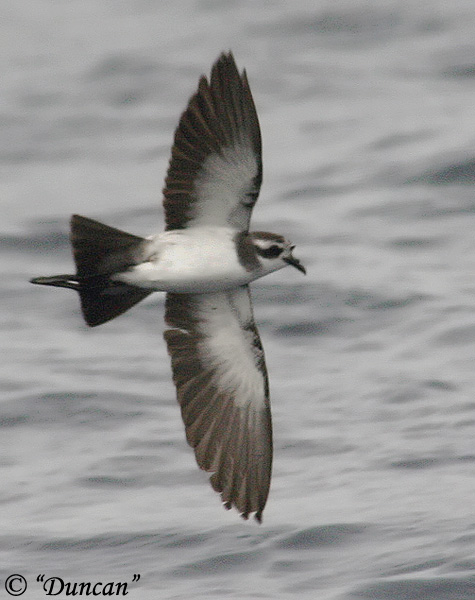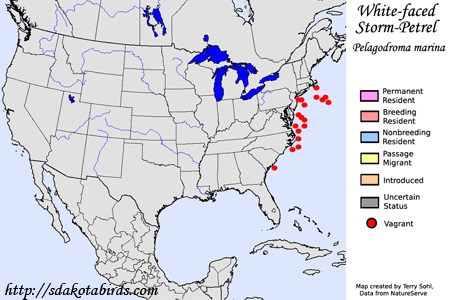White-faced Storm-Petrel
Pelagodroma marina
| Length: 7.5 inches | Wingspan: 18 inches | Seasonality: Non-resident in South Dakota |
| ID Keys: White underparts and face, dark upperparts, gray rump, wedge-shaped tail, dark stripe on face, dark neck band, dark tail | ||
 The
White-faced Storm-Petrel is a widespread speces in the Southern Hemisphere,
with breeding sites in the south Atlantic Ocean, the Indian Ocean, and the
southwestern Pacific near Australia and New Zealand. In the Northern
Hemisphere, they breed on select islands in the eastern Atlantic, and in
North America, they are relatively rare vagrants off the east coast of the
United States.
The
White-faced Storm-Petrel is a widespread speces in the Southern Hemisphere,
with breeding sites in the south Atlantic Ocean, the Indian Ocean, and the
southwestern Pacific near Australia and New Zealand. In the Northern
Hemisphere, they breed on select islands in the eastern Atlantic, and in
North America, they are relatively rare vagrants off the east coast of the
United States.
Habitat: Breeds on islands in scattered subtropical and temperate oceans across the globe. Outside of the breeding season, they are pelagic, often found just off the continental shelf in areas with upwelling currents.
Diet: Feeds mostly on small fish, fish eggs, small crustaceans, as well as other small ocean creatures.
Behavior: Forages by flying low over the water's surface and dipping down to the water's surface to "foot patter" and grab prey items.
Nesting: Colonial nester, with nests consisting of burrows They may also use natural crevices between rocks, or other protected areas. The female lays a single egg in the nesting chamber, and both parents help to incubate it. Upon hatching, both parents help to feed and raise the nestling.
Song: Usually silent while away from the breeding grounds.
Migration: Breeds on islands in widely scattered locations, including the Cape Verde and Salvages Islands in the North Atlantic, Gough Island and Tristan da Cuhna in the South Atlantic, as well as islands in the Indian Ocean, and near Australia and New Zealand. Outside of the breeding season, they are found in pelagic areas, across much of the southern Pacific, Indian, and Atlantic Oceans, as well as in the North Atlantic.
Interactive eBird map: Click here to access an interactive eBird map of White-faced Storm Petrel sightings
Similar Species: In North America, the white underparts make it distinguishable from other Storm-Petrel species found in the North Atlantic. The facial pattern leads to occasional confusion with Phalarope species.
Conservation Status: Global populations may be in decline, but the species is still widespread and common in many areas. The IUCN lists the White-faced Storm-Petrel as a species of "Least Concern".
Further Information: 1) Audubon Guide - White-faced Storm-Petrel
2) BirdLife International - White-faced Storm-Petrel
3) New Zealand Birds Online - White-faced Storm-petrel
Photo Information: Photo taken by "Duncan" - Photo licensed under Creative Commons Attribution ShareAlike 2.0 Generic License.
| Click below for a higher-resolution map |
 |
| South Dakota Status: Non-resident in South Dakota |
Additional White-faced Storm-Petrel Photos (coming soon!!)
